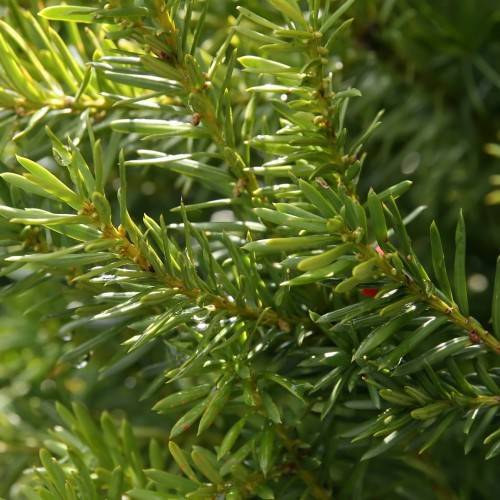
yew
Taxus media 'Citation'
Cycle:
Perennial
Watering:
Average
Hardiness Zone:
4 - 7
Flowers:
Flowers
Sun:
Full sun,part shade
Cones:
Yes
Leaf:
Yes
Growth Rate:
High
Maintenance:
Low
Poisonous To Humans:
Yes
Poisonous To Pets:
Yes
Salt Tolerant:
Yes
Thorny:
Yes
Care Level:
Medium
watering
Yew (Taxus media 'Citation') should be watered regularly and deeply during its active growing season, from spring to early fall. During this time, it should receive about 1.25 to 1.5 inches of water every week. When rainfall is not sufficient, supplemental watering with a garden hose or a drip system can be used to provide the correct amount of water, since yews are susceptible to drought. Water should be applied evenly around the base of the yew to dampen the entire root zone. Soil should be allowed to nearly dry out between waterings, but not completely. During the dormant season in late fall and winter, yews should receive much less watering, but there should still be some. About 1/2 inch of water per month is sufficient, but should only be applied if the soil has started to dry out.
sunlight
Yew (Taxus media 'Citation') is a plant species which requires moderate amounts of sunlight and should be exposed to it at least 4 to 5 hours daily. They can survive in partial shade but will produce better growth when receiving more amounts of sunlight. It is best to provide yews with full sun in the early morning hours or late afternoon and should be positioned in a location where they will be exposed to direct sunlight. Too much direct sunlight can burn the foliage of yews, so it is important to be mindful of how much sunlight they are receiving when positioning them in an outdoor location.
pruning
Yews (Taxus media 'Citation') are evergreen shrubs that require light pruning for shape. When pruning yews, care should be taken to maintain the naturally columnar shape of the shrub. The best time to prune a yew is in the late winter or early spring, just before or as new growth begins. During this time, the yew is dormant and is not actively growing or producing sap, so pruning can be done safely. When pruning yews, avoid major shearing or cutting of large branches. Instead, cut away dead or damaged branches first. Then, selectively prune the foliage to keep the shrubs at a desired size or shape. Keeping the foliage evenly distributed along the main stem or branches will help create a fuller, more aesthetically pleasing foliage. Light pruning of late summer or early fall growth may also be necessary to maintain the shrub's shape.
